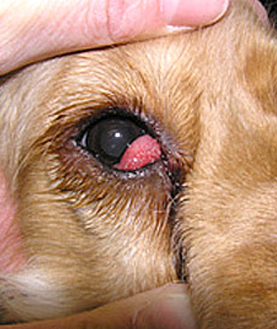Treatment Of Cherry Eye
Cherry eye may sound like a funny name for an abnormality, but pet owners and veterinarians know it is no laughing matter. The term cherry eye refers to a prolapse or inversion of the third eyelid, also known as the nictitating membrane.Owners will notice this problem right away as the visible symptoms of cherry eye include a large, fleshy mass located in the corner of their pet’s eye. The fleshy mass is followed by abnormal tear productions and a discharge or drainage from the eye. Cherry eye can not only be irritating to the pet but can also cause a great deal of vision imparity; therefore, it should be treated promptly.
The most common treatment for cherry eye is a surgical approach; however, on occasion this abnormality can be resolved using antibiotics and steroids. The steroids will relive the swelling, and antibiotics can relive some of the drainage. Sometimes, the prolapsed will even correct itself withoutinterference, and on other accounts, slight physical manipulation and medication can correct the problem. If attempts at a nonsurgical correction fail, surgical corrections are necessary.
Surgery is the most common and most effective method of treating cherry eye. The basic goal of surgery involves fixing the  prolapsed gland by anchoring the membrane to the orbital rim. In severely infected cases, an antibiotic eye ointment will be used. A complete removal was once an accepted treatment due to the cosmetic appeal of the eye. However, although the eye may have appeared normal,but it was not fully functional. Complete removal of the gland means that there will be no tear production to lubricate the eye, causing it to become dry and useless after time.
prolapsed gland by anchoring the membrane to the orbital rim. In severely infected cases, an antibiotic eye ointment will be used. A complete removal was once an accepted treatment due to the cosmetic appeal of the eye. However, although the eye may have appeared normal,but it was not fully functional. Complete removal of the gland means that there will be no tear production to lubricate the eye, causing it to become dry and useless after time.
Two basic surgical procedures are used now: the anchoring method discussed before and the envelope or pocket method. The latter method involves a simple suture of the tissue around the prolapsed area, leading to a closure. However this method can lead to other problems, including cysts. After a thorough examination,a veterinarian can guide pet owners through the best approach to treating their pet’s cherry eye condition.






